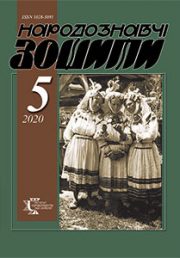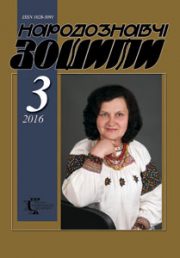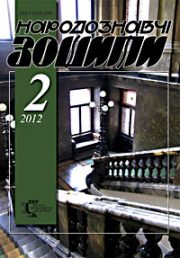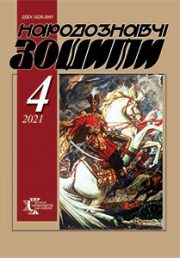The Ethnology Notebooks. 2019, № 6 (150), 1645—1657
UDK391:63-055.1″196/197″(477)
DOI https://doi.org/10.15407/nz2019.06.1645
CHUBOTINA Iryna
ORCID ID: https://orcid.org/0000-0001-8436-0086
Postgraduate student Kyiv National University
of Culture and Arts
str. Evgeni Konovalets, 36, 01133, Kyiv, Ukraine
e-mail: iri-s83@outlook.com
Abstract. Introduction. The article dwells upon the peculiarities of evolution of the men’s clothing in the Ukrainian village. The research is based on the materials of O. Medvedev, a country expert. Memories and reflections of spectators and participants fixed in the village surrounding in the 1960th—1970th are the most valuable, since their achievements made the greatest impact on the present day men’s clothing. Problem Statement. The article is dedicated to the studies of the nature of these changes, as well as to the mutual influence of the rural and the urban men’s fashion in the 196-th—1970-th. There was carried out an art analysis of the urban and the rural Ukrainian costume. There were outlined artistic principles, peculiarities of fashion development in the traditional lifestyle of the Ukrainian village, as well as the turning points in the history of the men’s costume in Kyiv region. Purpose. The purpose of the article is to present the characteristics of a men’s rural costume in the context of the design of clothing in the 1960s and 1970s and to identify the features of its transformations and influence on the further development of the male image. Methodology. The article relies mainly on historical-cultural and comparative approaches as well as elements of structural-typological and geographical methods of ethnology and fashion studies. As a result, it was stated that the men’s costume becomes an actual reflection of the changes in the social and cultural life during the period of the «Thaw» in Ukraine. Conclusion. During this period there can be witnessed the change in both — in the costume itself, and in the attitude to it. Thus, fashion tendencies existing in the urban surrounding in the early 60-th were almost neglected by the rural clothing, whereas in the late 70-th it’s assortment and the character of the men’s rural and urban clothing becomes finally identical.
Keywords: Ukrainian rural clothes, men’s costume, fashion of the 1960s—1970s, clothes design.
Received 19.11.2019
REFERENCES
Selivachov, M.R. (Ed.). (2008). About rural fashion in Ukraine in the mid-twentieth century. Narodnyi kostium yak vyraznyk natsionalnoi identychnosti: zbirnyk naukovykh prats za red. M. Selivachova (Pp. 53—57). Kyiv: KhIK [in Ukrainian].
Vorobiei, O. (2015). Women’s clothing of the 1960’th and 1980’th (based on expedition materials from the villages of Podillya). Trybuna molodoho doslidnyka; Narodna tvorchist ta etnolohiia, 2, 103—112. ISSN 0130-6936 [in Ukrainian].
Kara-Vasylieva, T.V., & Chehusova, Z.A. (2005). Decorative art of Ukraine of XX century. «In search of great style». Decorative art of Ukraine of XX century. «In search of great style». Kyiv: Lybid [in Ukrainian].
Tkanko, Z.M. (2015). Fashion in Ukraine of the XX century. Lviv: Artos [in Ukrainian].
Kostelna, M.V. (2013). Activity of Ukrainian houses of clothing models in the 60—80’th of the XX century: concepts of the development of fashion trends. Visnyk Lvivskoi natsionalnoi akademii mystetstv, 24, 36—48 [in Ukrainian].
Kokorina, H.V. (2017). 1940—1990 Fashion: Ukrainian Chronicle. Visnyk KhDADM, 5, 73—79 [in Ukrainian].
Barlett, Dj. (2011). Fashion East: The Spectre that Haunted Socialism. Moscow: Novoe literaturnoe obozrenie [in Russian].
Khomenko, S. (2013). Qualitative changes in the living conditions of Ukrainian peasants. Hileia: naukovyi visnyk, 74, 69—72 [in Ukrainian].
Kovpak, L.V. (2003). Social and living conditions of the population of Ukraine in the second half of the twentieth century (1945—2000). (Dr. hist. sci. diss. abstr.). Kyiv [in Ukrainian].
Oliinyk, M. (2017). Ukrainian clothes in the system of urban culture of Kyiv (second half of XIX — beginning of XXI century). Kyiv: NAN of Ukraine; IMFE. ISBN 978-966-02-8365-7 [in Ukrainian].
Vovk, V.M. (2007). Urban life and leisure of the urban population of Ukraine in the 1950—1980s. XX century (Doctoral dissertation). Kyiv [in Ukrainian].
Lebina, N.B. (2014). Man and woman: body, fashion, culture. USSR — the thaw. Moscow: Novoe literaturnoe obozrenie [in Russian].
Models of clothing. (1962). Kyivskyi budynok modelei. Albom modelei odiahu. Kyiv [in Ukrainian].
Fashion. (1966). Kyiv: Oktiabr [in Ukrainian].
Bilan, M.S. & Stelmashchuk, H.H. (2011). Ukrainian clothes. Lviv: Apriori [in Ukrainian].
Lerman, Ya. (2018) History of male Ukrainian fashion: 70—80s. L`Officiel. Kyiv. Retrieved from: https://officiel-online.com/style/the-history-of-men-s-ukrainian-fashion-70-80-s/ (Last accessed: 17.09.2018) [in Russian].
Fashion. (1970). Kyivski budynky modelei proponuiut. Kyiv: Reklama [in Ukrainian].
Your home is Kyiv. (1976). Kyiv: Reklama [in Ukrainian].
rainian].







